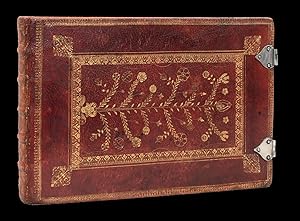Beschreibung
An album of engravings from the most famous natural history artists of the late sixteenth and early seventeenth centuries, collected and bound for an English patron Oblong quarto (260 by 170mm), 176 engraved plates, numbered in an early hand 1-46, 48-54, 57-69, 80-189, including 8 title-pages, all with fine contemporary hand-colour in full, occasionally heightened in silver, two plates torn with slight loss to image and with early repairs, six plates with slight worming to margins, and three plates trimmed to neatline and laid down on old paper, front free endpaper with later ownership inscription; mid-seventeenth century English red morocco, elaborately gilt, silver clasps and catches. A magnificent album of natural history engravings, collected and bound for an English patron, containing two complete suites of plates: Hoefnagel's 'Diversæ insectarum volatilium'; and Woutneel's 'Cognoscite lilia agri quomodo crescent', often bound as the fifth part, 'Altera Pars', to the Crispin de Passes' 'Hortus Floridus' - the "most ambitions, if not the first, early effort to employ Continental resources to produce a set of [botanical] engravings designed for the English market" (Gerard); and nine near complete, or partial suites, including an early issue of tulip plates from the 'Hortus Floridus'. All plates have been numbered consecutively in manuscript at the time of binding to a rudimentary scientific rubric: insects first, then aquatic animals, quadrupeds, birds, and botanicals last, but not least. As a result, some plates are bound with like subject rather than with their original publications. The album represents the work of some of the most famous natural history artists of the late sixteenth and early seventeenth centuries. The majority are published by Claes Jansz Visscher (1587-1652), the most important publisher of prints and maps in Amsterdam of his day. Recorded as an engraver in Amsterdam as early as 1608, he built a distinctive inventory of prints after the designs of Flemish artists, which proved extremely popular and formed the basis ofVisscher'searly success as a publisher. INSECTS HOEFNAGEL, Jacob. Diversæ insectarum volatilium: icones ad vivum accuratissmè depictæ per celeberrimum pictorem D.I. Hoefnagel typisq. Mandatae a Nicolao Ioannis Visscher anno 1630 Engraved title-page, complete with 15 numbered plates of insects, misbound including some upside-down, bound with plates 11 and 12 from 'Volatilium varii generis effigies' after Nicolaes de Bruyn, all with contemporary hand-colour heightened in silver, consecutively numbered in an early hand 1-18. North German insects, with the exception of the tarantula and scorpion. Engraved by Visscher after those by Jacob Hoefnagel, 1573-1632, court painter for Emperor Rudolph from 1607, son of Joris Hoefnagel, whose drawings of animals, flowers and insects he engraved and published as the 'Archetypa Studiaque Patris Georgii Hoefnagelii' (1592). He also engraved plates for Braun and Hogenburg's 'Civitates Orbis Terrarum' (1512 - 1617). Ebert 798; Hagen I, 371f; Hollstein IX, 46, 1-16; Nissen 1955; Horn-Schenkl. 10473. AQUATIC ANIMALS BRUYN, Nicolaes de. Libelius [sic] varia genera piscium compectens, pictoribus, sculptoribus etc mire utilis et necessaries Nicolaes de Bruyn inventor Claes Ianss. Visscher excudit. [interspersed with]: COLLAERT, Adrian. Piscium vivae icones inventae ab Adrian Collardo et excusae a Nicolao Ioannis Visscher anno 1634 Engraved allegorical title-page for 'Libillus', 11 (of 12, without the sea-horse) plates of aquatic animals and sea-monsters; 19 (of 20) engraved plates of aquatic animals, numbered in an early hand 19-44, followed by the allegorical title-page for 'Piscium', numbered 45, all with contemporary hand-colour, all annotated in an early hand with common names in English. An early state of the title-page for de Bruyn's 'Libellus' before correction. Nicolaes de Bruyn (1571-1656) is best known for his large engraved landscapes "after designs b. Bestandsnummer des Verkäufers 16352
Verkäufer kontaktieren
Diesen Artikel melden
![]()




